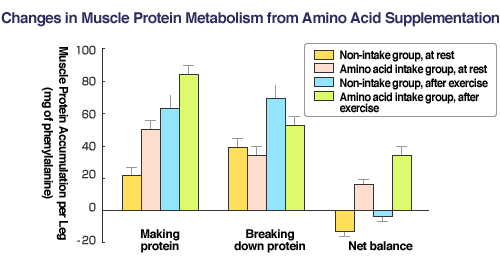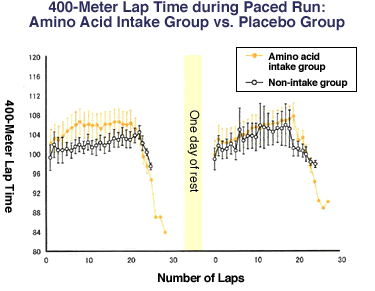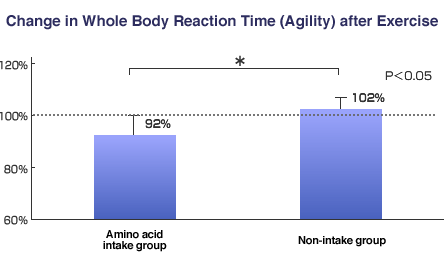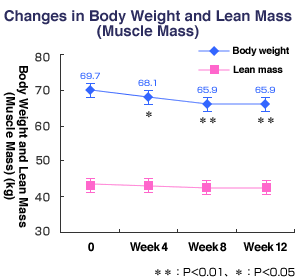- Home
- Company
- Amino Acid Encyclopedia
- Find Out the Secrets of Amino Acids!
- Sports and Amino Acids
Sports and Amino Acids
Amino acids can improve your performance in many different ways!

![]()
-
Did you know that the muscles in our bodies are made of protein? Valine, leucine and isoleucine are called branched-chain amino acids (BCAAs). 40% of the essential amino acids that make up muscle protein are BCAAs.
Together with BCAAs, the amino acids arginine, glutamine and cystine/theanine also help the body to move and function. Supplementing your body with these amino acids you can promote your health and enjoy sports more.
![]()
Amino Acids also Reduce Muscle Soreness!
There are several kinds of muscle soreness. One is delayed-onset muscle soreness (DOMS) when soreness is felt anywhere from several hours to several days after exercise. DOMS can also cause muscle damage and inflammation. A study was conducted to find out if taking amino acids reduces DOMS. One group took amino acids including BCAAs and the other group took no amino acids. The subjects did several rounds of repetitive elbow flexor exercises and researchers measured the muscle soreness and damage they experienced. The group that took amino acids said they had less muscle soreness and damage showing that taking amino acids is beneficial.

Nosaka et al., Int. J. Sport. Nutr. Exerc. Metabol., 16, 620-635 (2006)
Amino Acids for Golfing
Golf can be very physically demanding on the body especially for casual golfers who may play once a month and only exercise occasionally. Over the course of a round of golf golfers can become progressively fatigued, which affects the accuracy of their swing and planting of the feet. Instead of benefiting from the exercise, as the round progresses, the body breaks down the proteins in muscles to use for energy. This can lead to muscle fatigue. Golfers can take BCAAs and other amino acids to reduce fatigue in the latter holes and perform better. To study the effects of taking amino acids on golf 12 subjects were divided into a group taking amino acids and a group taking a placebo. The group that took amino acids showed an average improvement of 1.3 strokes compared with the placebo group in the last three holes (holes 16 to 18) when fatigue is highest. This shows that taking amino acids reduces muscle damage and fatigue.

Katayama et al., Japan Society of Training Science for Exercise and Sport (2008)
Taking Amino Acids during a Marathon to Improve Performance
Marathons are particularly demanding on the body. They require a high level of muscle strength and endurance. During a marathon, muscle proteins are both made and broken down in muscle at the same time. Taking amino acids during exercise helps to both promote the making of muscle proteins and reduce the breakdown of muscle proteins. This efficiently increases the muscle proteins in the body.

Biolo et al., Am. J. Physiol. Endocrinol. Metab., 273, E122-9 (1997)
In a marathon where participants exercise continuously for multiple hours the body uses up its stores of glycogen and fat for energy. Once this is used up the body begins to take amino acids from muscle proteins to burn for energy, which causes muscle damage. By consuming amino acids it is possible to reduce muscle damage to maintain stamina.
Consuming amino acids also helps to repair muscle damage and enable faster recovery. A study was conducted where the subjects were asked to run 25 laps of a 400-meter track on two separate days with a rest day in between. The subjects ran a total of 20 kilometers over two days. On the first day of running, the group that took a placebo recorded better times than the group that took amino acids. On the second day of running (following a rest day) the placebo group recorded slower times relative to their times from two days before. There was only a small gap in times between the two groups.

Ohtani et al., 49th ACSM in St. Louis (2002)
In a separate study 193 marathon participants were divided into a group taking 16 grams of BCAAs and a placebo group to measure their times. Among runners who recorded a time between 3:05 and 3:30 the runners who took amino acids on average recorded an improvement of five to six minutes. Source: Blomstrand et al., Eur. J. Appl. Physiol. Occup. Physiol., 63(2), 83-8 (1991)
Using Amino Acids for Mountaineering
Mountaineering can be particularly demanding on the muscles of the lower body as climbers must ascend and descend sharp grades for long periods. Like other endurance activities muscle damage can occur as the body uses up its glucose and fat stores and begins to break down muscle proteins to burn for energy. While you might think ascending is harder than descending, descending requires the extension rather than contraction of muscles, which is actually less natural and causes more damage to the legs. Studies have also shown that the legs take double the impact when descending compared to ascending. As a result climbers can sometimes not be aware of the progressive damage to their muscles while descending and this fatigue can lead to accidents such as falls or slips.
A study was conducted to investigate the effectiveness of taking amino acids for mountaineering. Eight subjects simulated a climb to an elevation of 1,200 meters using the stairs of a high-rise building ascending and descending the stairs to measure important functional markers for climbing safety. The group that took amino acids outperformed the placebo group for agility in instantly reacting to danger as well as balance needed to stay upright on poor footing. Minimizing of the performance decline were observed after exercise. The group that took amino acids were thought to have experienced less muscle damage compared with the placebo group, which resulted in less fatigue.

Hagiwara et al., Japanese Society of Mountain Medicine, 28, 103-112 (2008)
Using Amino Acids and Exercise Wisely to Address Metabolic Syndrome
Researchers are taking a close look nowadays at how basal metabolism affects metabolic syndrome. Metabolism relates to essential functions in our body such as breathing and body temperature. Basal metabolism accounts for approximately 70% of our daily energy consumption but generally slows down as we get older. Much of our basal metabolism is energy consumed by muscle. By increasing our muscle mass we can also increase our metabolism, reduce our body fat percentage and help tackle metabolic syndrome.
To increase muscle mass it is recommended to combine suitable amounts of regular exercise with consumption of amino acids, including BCAAs that are used to make muscle and help increase muscle mass. If you don't already exercise and suddenly begin exercising you may experience a high degree of muscle fatigue and delayed-onset muscle soreness (DOMS), which can keep you from exercising. By taking amino acids you can reduce muscle fatigue and DOMS so that you can exercise more efficiently.
A study was conducted to examine the effects of combining exercise and amino acid intake on metabolic syndrome. Seven women who had been declared obese (average height of 161 cm, weight of 69.7 kg, 37.5% body fat, BMI of 26.8) took a daily five gram supplement of amino acids for three months. In the first two months of the study the subjects were asked to exercise by walking twice a week for 40 minutes at a time then instructed to stop walking in the third month. The body weight of the subjects decreased starting from the first month. In the third month, even after the subjects quit walking for exercise their body weight did not rebound and increase again. That means that the subjects were able to decrease their body fat percentage by the end of the study. These results indicate that combining amino acid intake and exercise increased the muscle protein mass of the subjects so that their basal metabolism rose.

Ogasawara et al., Japanese Society of Training Science for Exercise and Sport (2007)

